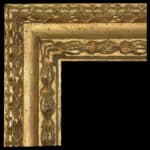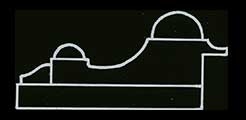Baroque picture frame
Reproduction of an Italian Baroque picture frame carved and gilt on ayous wood. This Bolognese early 17th-century Baroque frame is available for any painting size. Therefore, you can fit it with any painting.
Properties
This reproduction frame is made with ayous and tulipwood combined. We use ayous for the front side and tulipwood for the backside of the frame. As a result, we obtain the maximum strength with the minimum weight.
You can customize the rabbet width as you prefer. For instance, if you need to cover a bigger part of the painting, you can ask to enlarge it. The rabbet depth, instead, depends on the thickness of the painting. In most of our models, it is between 1.5 and 4 cm. Sometimes, it is even deeper due to structural reasons or upon request.
Section width cm 12
Rabbet cm 1
Decorations of Baroque frame
Decorations are made from wood pulp. We carve them when they are dry, giving the ornates a lovely shape. Wood pulp, which is 99% composed of wood and 1% solvent, allows us to keep the price very low. The entire process is handmade; you can watch the video below to see the carving process.
If you wish to see the mounting process of the wood pulp decorations on this Baroque picture frame, link here: mounting process
You can still order this frame entirely carved on wood for a different price. We would use softwood Swiss pine to carve it. Ask for a quote if you are interested in this reproduction of a reverse cassetta frame made completely of wood.
Patina (aging process)
“Patina” is an Italian word that refers to the tone of the final gilding of the frame. Making an astonishing Patina is one of the major skills of the gilder in order to make this reproduction of a Baroque frame seem like an original one. In other words, it concerns the process of aging the gold finishing, trying to distress the reproduction frame as much as possible without exaggerating too much.
To complete the procedure, gilders use different stones to hit the frame, creating some fake, tiny, broken parts around the sides. Besides, gilders create fake wormholes to age the gilding, and you can see them deeply analyzing the picture details attached above.
Another essential part of the patina is gently rubbing off the gold surface with steel wool, trying to make the typical antique abrasions you see in antique picture frames. In conclusion, any damaged little part of the frame is just a part of a bigger plan.
See below a video showing all the steps of the Patina.
More videos related to the aging process
Explanation of the aging process
Distressing the gold surface
Rub off the gilding
Dark shellac
Applying shellac
Final result
CHEAPER MODELS OF BAROQUE PICTURE FRAME
See below for models of Baroque-style frames with similar structures but at a lower price.




